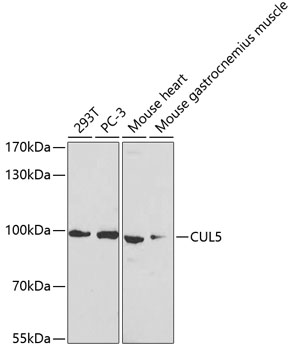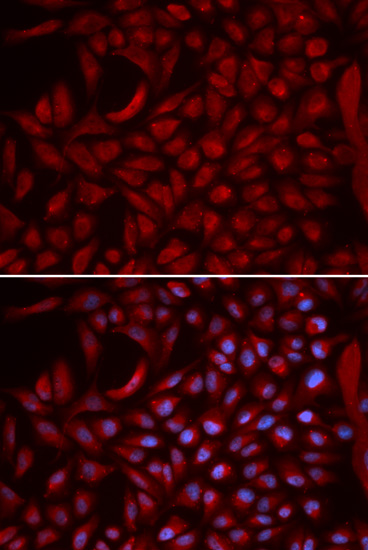-
Product Name
CUL5 Polyclonal Antibody
- Documents
-
Description
Polyclonal antibody to CUL5
-
Tested applications
WB, IF
-
Species reactivity
Human, Mouse
-
Alternative names
CUL5 antibody; CUL-5 antibody; VACM-1 antibody; VACM1 antibody; cullin-5 antibody
-
Isotype
Rabbit IgG
-
Preparation
Antigen: Recombinant fusion protein containing a sequence corresponding to amino acids 1-300 of human CUL5 (NP_003469.2).
-
Clonality
Polyclonal
-
Formulation
PBS with 0.02% sodium azide, 50% glycerol, pH7.3.
-
Storage instructions
Store at -20℃. Avoid freeze / thaw cycles.
-
Applications
WB 1:500 - 1:2000
IF 1:50 - 1:200 -
Validations

Western blot - CUL5 Polyclonal Antibody
Western blot analysis of extracts of various cell lines, using CUL5 Antibody at 1:1000 dilution.Secondary antibody: HRP Goat Anti-Rabbit IgG (H+L) at 1:10000 dilution.Lysates/proteins: 25ug per lane.Blocking buffer: 3% nonfat dry milk in TBST.Detection: ECL Basic Kit .Exposure time: 90s.

Immunofluorescence - CUL5 Polyclonal Antibody
Immunofluorescence analysis of U2OS cells using CUL5 antibody . Blue: DAPI for nuclear staining.
-
Background
Core component of multiple SCF-like ECS (Elongin-Cullin 2/5-SOCS-box protein) E3 ubiquitin-protein ligase complexes, which mediate the ubiquitination and subsequent proteasomal degradation of target proteins. As a scaffold protein may contribute to catalysis through positioning of the substrate and the ubiquitin-conjugating enzyme. The functional specificity of the E3 ubiquitin-protein ligase complex depends on the variable substrate recognition component. ECS(SOCS1) seems to direct ubiquitination of JAK2. Seems to be involved in proteosomal degradation of p53/TP53 stimulated by adenovirus E1B-55 kDa protein. May form a cell surface vasopressin receptor.
Related Products / Services
Please note: All products are "FOR RESEARCH USE ONLY AND ARE NOT INTENDED FOR DIAGNOSTIC OR THERAPEUTIC USE"
